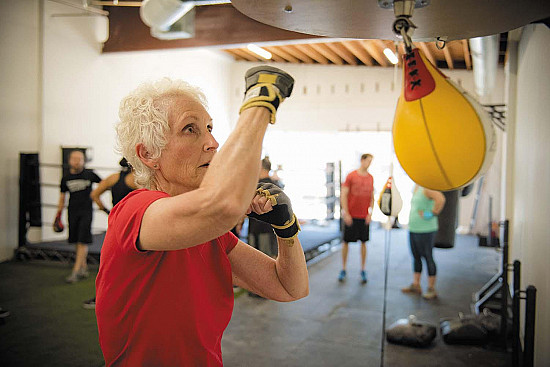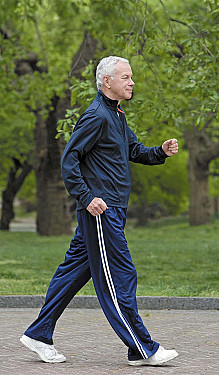How much do you sit, stand, and move each day?
Swapping even just a few minutes of sitting with movement may lead to tangible improvements in heart health.
- Reviewed by Christopher P. Cannon, MD, Editor in Chief, Harvard Heart Letter; Editorial Advisory Board Member, Harvard Health Publishing

Let's say you sleep about eight hours a night. During the 16 hours you're awake, are you sitting for much of that time? If that's the case, you can improve your cardiovascular health by moving — or even simply standing — more during the day.
This advice is hardly new, as experts have been sounding the alarm about the health hazards of sedentary behavior for decades. Now, a new study sheds light on how different types and amounts of activity may affect indicators of heart health, such as body mass index (BMI), cholesterol values, and blood sugar levels.
"It's the first study to look at how different movement patterns over an entire 24-hour period may affect those factors," says Dr. Edward Phillips, associate professor of physical medicine and rehabilitation at Harvard Medical School. That's important because whenever you make any type of lifestyle change, it's helpful to know not just what you're adding but also what you're subtracting. For example, when people eat more fruit, they may eat fewer cookies, and both shifts are beneficial. Likewise, people are better off when they move more and sit less, he says. The new findings include estimates about the potential advantages of choosing different activities — including sleeping — in place of sitting.
How was the study done?
Published online Nov. 10, 2023, by the European Heart Journal, the article includes data from more than 15,000 people participating in six studies from five different countries. Their average age was 54, and nearly 55% were women. Most (88%) rated their health as good or better. Researchers assessed the participants' heart health based on their BMI (a measurement that incorporates both weight and height), waist circumference, cholesterol and triglyceride levels, and HbA1c (a measure of blood sugar used to assess diabetes risk). About a third were taking medication to control cholesterol, high blood pressure, or diabetes, and about 10% had been diagnosed with heart disease.
Participants wore special activity monitors that attach to the front of the thigh. These monitors are more accurate than those worn on the hip or the wrist for discerning between sitting and standing. Based on a week's worth of data, the average participant's day consisted of 7.7 hours sleeping, 10.4 hours sitting, 3.1 hours standing, 1.5 hours doing light physical activity, and 1.3 hours doing moderate-to-vigorous physical activity.
Note that the participants probably didn't do 1.3 hours of structured moderate- or vigorous-intensity exercise per day. Rather, the trackers recorded and added up all their short bouts of activity, such as walking up a flight of stairs or running to catch a bus, says Dr. Phillips.
What did the study find?
Not surprisingly, researchers found that moderate-to-vigorous activity proved most beneficial for heart health, while sitting was the worst. Next, they created statistical models to estimate what would happen if a person swapped one behavior for another. Replacing even just five minutes of sitting with moderate-to-vigorous activity (such as brisk walking, running, or cycling) could have a tangible effect on heart health, they reported.
Of course, extending that swap time to 30 minutes is even better. As an example, they estimated the potential change in BMI from doing moderate-to-vigorous activity instead of 30 minutes daily of each of the four other activities. Routinely replacing light activity with moderate activity could nudge down BMI by about 0.15 points. Swapping standing or sleeping with moderate activity could lower BMI by 0.40 and 0.43 points, respectively. But replacing sitting with moderate activity could lower BMI by 0.63 points.
While adding longer, more intense bouts of exercise can reap greater rewards, even small, modest changes can make a difference. For instance, replacing sitting with standing led to positive changes across all the health parameters. "I tell my patients to take any opportunity to add more movement into their day, or even just standing instead of sitting all day," Dr. Phillips says.
The sleep quotient
While the model suggests that even sleeping is better than sitting when it comes to heart health, it's not quite that simple. For example, indirect factors that lead to weight gain (for example, snacking while watching television.) may explain why sitting appears worse than sleeping.
In addition, there's good evidence linking sleep deprivation with poor metabolic health. "When you're tired, you're less likely to exercise and won't eat as healthfully, and you feel more stressed," says Dr. Phillips. So if you're sleep deprived (that is, you routinely get less than six hours of sleep per night), you should prioritize getting at least seven hours of shuteye every night rather doing more exercise.
What else can you do?
One simple trick to make sure you get up out of your chair regularly? "Fill up a water bottle and drink it throughout the day, so you'll have to get up to use the bathroom," says Dr. Phillips. Another helpful habit: take a short stroll after lunch or dinner. "Using the large muscles in your legs helps absorb the glucose load from the meal, which helps regulate your blood sugar and insulin levels," he explains.
A fitness band or smart watch can help you keep tabs on your daily activity, including how much you exercise and sleep. Some models include default reminders to stand up at least once an hour for at least 12 hours per day. But don't feel you have to get one of these devices, says Dr. Phillips. A smartphone (which nearly everyone has these days) does a fine job tracking your daily steps, provided you remember to carry it with you most of the day. If you take about 500 steps during a five-minute walk, that counts as brisk walking. "Don't worry if you have a slower pace. Just get out of your chair and get moving as much and as often as you can," he says.
Image: © Paul Bradbury/Getty Images
About the Author

Julie Corliss, Executive Editor, Harvard Heart Letter
About the Reviewer

Christopher P. Cannon, MD, Editor in Chief, Harvard Heart Letter; Editorial Advisory Board Member, Harvard Health Publishing
Disclaimer:
As a service to our readers, Harvard Health Publishing provides access to our library of archived content. Please note the date of last review or update on all articles.
No content on this site, regardless of date, should ever be used as a substitute for direct medical advice from your doctor or other qualified clinician.
















